5th Infantry Division (United Kingdom)
The 5th Infantry Division was a regular army infantry division of the British Army. It was established by Arthur Wellesley, 1st Duke of Wellington for service in the Peninsular War, as part of the Anglo-Portuguese Army, and was active for most of the period since, including the First World War and the Second World War and was disbanded soon after. The division was reformed in 1995 as an administrative division covering Wales and the English regions of West Midlands, East Midlands and East. Its headquarters were in Shrewsbury. It was disbanded on 1 April 2012.
| |
|---|---|
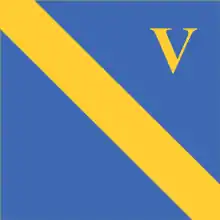 Shoulder sleeve insignia of the 5th Division, 1995 onwards | |
| Active | 1810–1815 1906–1922 1929–1947 1958–1960 1968–1971 1995–2012 |
| Country | |
| Branch | |
| Type | Infantry |
| Nickname(s) | The Globe Trotters The Gypsies The Fighting Fifth |
| Engagements | |
| Insignia | |
| c. 1939–Cold War period |  |
| c. First World War |  |
Peninsular War
The 5th Division during the Peninsular War under the command of General James Leith was present at most of the major engagements including the Battle of Bussaco, the Battle of Sabugal, the Siege of Almeida, the Battle of Badajoz, the Battle of Salamanca, the Battle of Vitoria, the Siege of San Sebastian, the Battle of Nivelle and the Battle of the Nive.[1]
Peninsular War order of battle
The order of battle in summer 1813 was:[2]
- 1st Brigade
- 3/1st (Royal Scots) Regiment of Foot
- 1/9th (Norfolk) Regiment of Foot
- 1/38th (1st Staffordshire) Regiment of Foot (from June 1812)
- 2/38th (1st Staffordshire) Regiment of Foot (to December 1812)
- 2/47th (Lancashire) Regiment of Foot (from October 1813)
- 1 Coy., Brunswick-Oels Jaegers
- 2nd Brigade
- 1/4th (King's Own) Regiment of Foot
- 2/4th (King's Own) Regiment of Foot (May to December 1812)
- 2/30th (Cambridgeshire) Regiment of Foot
- 2/44th (East Essex) Regiment of Foot
- 2/47th (Lancashire) Regiment of Foot (to October 1813)
- Portuguese Brigade
- 1/3rd Infantry Regiment, Portuguese Army
- 2/3rd Infantry Regiment, Portuguese Army
- 1/15th Infantry Regiment, Portuguese Army
- 2/15th Infantry Regiment, Portuguese Army
- 8th Caçadores Battalion, Portuguese Army
Waterloo Campaign
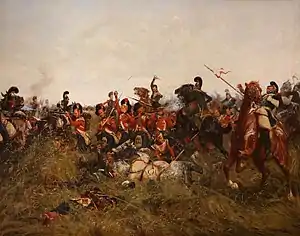
The division was also present during the Waterloo Campaign first seeing action at the Battle of Quatre Bras then at the Battle of Waterloo under the command of Lieutenant General Sir Thomas Picton.[3]
Waterloo order of battle
The division's order of battle at Waterloo was as follows:[3]
- 8th British Brigade, Major-General Sir James Kempt
- 9th British Brigade, Major-General Sir Dennis Pack
- 5th Hanoverian Brigade, Colonel Ernst von Vincke
- Landwehr Battalion Gifhorn
- Landwehr Battalion Hameln
- Landwehr Battalion Hildesheim
- Landwehr Battalion Peine
- Artillery, Major Heinrich Heise
- Roger's Battery, Royal Artillery
- Braun's Battery, Hanoverian Foot Artillery
Second Boer War
On the outbreak of war in 1899 an Army Corps of three divisions was sent to South Africa from the UK; the troops already there constituted the 4th Division. The rapid deterioration of the situation led the War Office to announce on 11 November 1899 that a 5th Division was to be formed and sent out. This consisted of the 10th and 11th (Lancashire) Brigades and concentrated at Estcourt on 8 January 1900.[4][5][6] Under the command of Lieutenant-General Sir Charles Warren, 5th Division joined up with the Natal Field Force shortly after the Battle of Colenso and was a part of the relieving army of the besieged Ladysmith.[7]
Second Boer War order of battle
The division was constituted as follows:[8][9]
- Commanded by Major-General John Talbot Coke.
- 2nd Battalion Dorset Regiment
- 2nd Battalion Middlesex Regiment
- 2nd Battalion Somerset Light Infantry
- Yorkshires and Warwickshires being left at Cape Colony[11]
- Imperial Light Infantry joined later
- Initially commanded by Major-General Edward Woodgate,[13] who was wounded at Spion Kop and died shortly afterwards. He was succeeded by Major-General Arthur Wynne who was later wounded at the Battle of the Tugela Heights and was temporarily succeeded by Brigadier-General Walter Kitchener.[14]
- 2nd Battalion Kings Own Royal Lancasters
- 2nd Battalion Lancashire Fusiliers
- 1st Battalion South Lancashire Regiment
- 1st Battalion York and Lancaster Regiment
- 37th Company
First World War
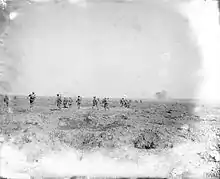
The 5th Division was a permanently established Regular Army division that was amongst the first to be sent to France as part of the original British Expeditionary Force (BEF) at the outbreak of the First World War. It served on the Western Front for most of the war except for a brief period on the Italian Front[16] from 27 November 1917 to 1 April 1918.[17] The 5th Division, as a Regular Army formation (one of the Old Contemptibles) fought in many of the major battles of the Western Front from the Battle of Mons in 1914, the later stages of the Somme offensive, including the first battle using tanks, up to the Battle of the Selle in 1918.[16]
Order of battle
The order of battle was as follows:[16]
13th Brigade
The 13th Brigade was temporarily under the command of 28th Division between 23 February and 7 April 1915, when it was replaced by 84th Brigade from that Division.
- 2nd Battalion, King's Own Scottish Borderers
- 2nd Battalion, Duke of Wellington's Regiment (left January 1916)
- 1st Battalion, Queen's Own (Royal West Kent Regiment)
- 2nd Battalion, King's Own Yorkshire Light Infantry (left December 1915)
- 1/9th (City of London) Battalion (Queen Victoria's), London Regiment (joined November 1914, left February 1915)
- 14th (Service) Battalion, Royal Warwickshire Regiment (joined December 1915, became Divisional Pioneers October 1918)
- 15th (Service) Battalion, Royal Warwickshire Regiment (joined January 1916, disbanded October 1918)
- 16th (Service) Battalion, Royal Warwickshire Regiment (joined October 1918)
- 13th Machine Gun Company, Machine Gun Corps (formed 24 December 1915, moved to 5th Battalion, Machine Gun Corps 26 April 1918)
- 13th Trench Mortar Battery (formed April 1916)[16][18]
14th Brigade The 14th Brigade transferred to 32nd Division on 30 December 1915
- 1st Battalion, Devonshire Regiment (left 12 January 1916)
- 2nd Battalion, Suffolk Regiment (left September 1914)
- 1st Battalion, East Surrey Regiment (left 12 January 1916)
- 1st Battalion, Duke of Cornwall's Light Infantry (left 12 January 1916)
- 2nd Battalion, Manchester Regiment
- 1/5th Battalion, Cheshire Regiment (joined February 1915, left November 1915)
- 1/9th (Highlanders) Battalion, Royal Scots (joined November 1915)
- 2nd Battalion, Royal Inniskilling Fusiliers (joined November 1915)
- 14th Machine Gun Company, Machine Gun Corps (formed December 1915, moved to 5th Battalion, Machine Gun Corps 26 April 1918)
- 14th Trench Mortar Battery (formed April 1916)
15th Brigade The 15th Brigade was temporarily under the command of 28th Division between 3 March and 7 April 1915, when it was replaced by 83rd Brigade from that division.
- 1st Battalion, Norfolk Regiment
- 1st Battalion, Bedfordshire Regiment
- 1st Battalion, Cheshire Regiment
- 1st Battalion, Dorset Regiment (left December 1915)
- 1/6th Battalion, Cheshire Regiment (joined December 1914, left March 1915)
- 1/6th (Rifle) Battalion, The King's (Liverpool) Regiment (joined February 1915, left November 1915)
- 16th (Service) Battalion, Royal Warwickshire Regiment (joined December 1915, left October 1918)
95th Brigade 95th Brigade transferred from 32nd Division on 26 December 1915
- 12th (Service) Battalion, Gloucestershire Regiment (Bristol's Own) (joined December 1915, disbanded October 1918)
- 1st Battalion, Devonshire Regiment (joined January 1916)
- 1st Battalion, East Surrey Regiment (joined January 1916)
- 1st Battalion, Duke of Cornwall's Light Infantry (joined January 1916)
Artillery
- XV Brigade, Royal Field Artillery
- XXVII Brigade, Royal Field Artillery
- XXVIII Brigade, Royal Field Artillery (until 21 January 1917)
- VIII (Howitzer) Brigade, Royal Field Artillery (until 21 May 1916)
- 108th Heavy Battery, Royal Garrison Artillery (until 9 April 1915)
Engineers
- 17th Field Company, Royal Engineers (until 26 March 1915)
- 59th Field Company, Royal Engineers
- 1st South Midland Field Company, Royal Engineers (from 24 March until 10 April 1916)
- 2/1st North Midland Field Company, Royal Engineers (from 23 March until 19 May 1915)
- 1/2nd Home Counties Field Company, Royal Engineers (joined 2 February 1915; became 491st (Home Counties) Field Company 3 February 1917)
- 2nd Durham Field Company, Royal Engineers (joined 20 September 1916; became 527th (Durham) Field Company 3 February 1917)
Pioneers
- 6th Battalion, Argyll and Sutherland Highlanders (from 13 June 1916 until 5 October 1918)
- 14th (Service) Battalion, Royal Warwickshire Regiment (from 5 October 1918)
Insignia
The 5th Division was unusual among other British divisions in that no battle patches were worn on their tunics or helmets, aside from those briefly worn by New Army battalions bringing them from their former division.[19]
Interwar period
During the interwar period, the division spent time based in Egypt and then in Palestine. The latter occurred during the 1936–1939 Arab revolt in Palestine.[20]
Second World War

Upon the outbreak of the Second World War, in September 1939, the 5th Infantry Division was a Regular Army formation, commanded by Major-General Harold Franklyn, who had been in command since 1938. The division was based at Catterick under Northern Command. Both of its infantry brigades (the 13th and 15th) went to France to join the rest of the British Expeditionary Force (BEF) in early October 1939 as independent infantry brigades, but the divisional Headquarters crossed to France on 19 December 1939, coming under the command of Lieutenant-General Alan Brooke's II Corps from 23 December. By the new year of 1940 the division was reformed with three infantry brigades –the 13th, 15th and 17th, all commanded by men who would achieve high rank in the next few years.[21][22]
Globe Trotting
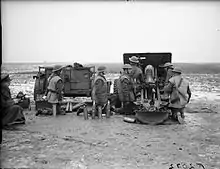
Throughout the early months of 1940 the division saw some changing of units, as the Territorial Army (TA) divisions began to arrive in France from the United Kingdom. This was part of official BEF policy, based on experience from the Great War, and was intended to strengthen the inexperienced TA formations with experienced Regulars, although at the same time diluting the strength of the Regular divisions with inexperienced TA units. Despite this, the division still maintained its integrity as a Regular formation. The next few months were spent in training, although this was hampered by severe shortages of modern equipment. Due to the lack of immediate action many soldiers believed the war would amount to very little. Despite this, morale in the division was high. This period of inactivity was known as the "Phoney War".[22]
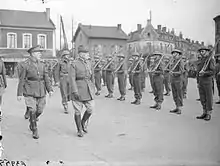
In mid-April the 15th Brigade was sent to Norway and fought, very briefly, in the unsuccessful Norwegian campaign, evacuating from there and arriving in the United Kingdom in early May, although it did not rejoin the 5th Division until 3 July 1940. In early May the 25th Infantry Brigade came temporarily under command of the division in France.[22][23] The German Army launched its attack in the West on 10 May 1940 and the 5th Division saw action in the battles of Belgium and France in May–June 1940 including the Battle of Arras, supported by the 1st Army Tank Brigade, on 21 May 1940 and at the Battle of the Ypres-Comines Canal from 26 to 28 May 1940, and then was withdrawn to Dunkirk, along with the rest of the BEF, where they were evacuated to England, with most of the division arriving on 1 June.[22] Lieutenant-General Brooke, commanding II Corps, wrote in his diary that there "is no doubt that the 5th Div in its fight on the Ypres-Comines canal saved the II Corps and the BEF".[24]
The division, having sustained very heavy losses, remained in the United Kingdom for the next 21 months, with most of 1940 being spent in Scotland under Scottish Command, reforming in numbers and being brought up to strength with large numbers of conscripts, alongside training in anti-invasion duties and preparing for Operation Sea Lion, the German invasion of the United Kingdom which never arrived. In late March 1941 the division, now under the command of Major-General Horatio Berney-Ficklin, who had taken over in July 1940 (and previously commanded the 15th Brigade), was sent to Northern Ireland, coming under command of Lieutenant-General James Marshall-Cornwall's III Corps, under overall control of British Troops Northern Ireland, and, as in Scotland, continued training to repel a German invasion there (see Operation Green).[21][25]
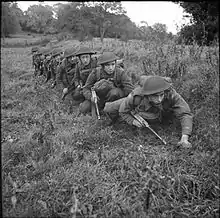
The division left Northern Ireland on 16 March 1942 and served and travelled in so many regions of the world that they were known as the Globe Trotters, and became the most travelled division of the British Army during the Second World War. In April 1942 the 13th and 17th Infantry Brigades and a portion of the divisional troops were detached to 'Force 121' for Operation Ironclad, the invasion of Vichy French held Madagascar. The division was not complete again until August 1942. It was sent from the United Kingdom to India for three months and then to Middle East Command, where it trained in mountain warfare.[21][22]
In mid-February 1943 the division was sent to Syria, remaining there for the next four months, and later Egypt, where it came under the command of British XIII Corps, commanded by Lieutenant-General Miles Dempsey (who earlier had commanded the 13th Brigade in France and Belgium in 1940), which was part of the British Eighth Army, under General Sir Bernard Montgomery. The division, serving again alongside the 50th Division, began training in amphibious operations in preparation for Operation Husky, the Allied invasion of Sicily.[22]
Sicily, Italy and North-Western Europe

The 5th Division saw action during the invasion of Sicily where, towards the end of the campaign, in early August, the divisional commander, Major-General Berney-Ficklin, who had commanded the division since July 1940, was replaced by Major-General Gerard Bucknall.[21] The division was pulled out of the line and absorbed replacements, and invaded the Italian mainland in Operation Baytown on 3 September (four years since Britain's entry into the war), still as part of XIII Corps of the Eighth Army, but now serving alongside the 1st Canadian Infantry Division, and advanced up the spine of Italy. Later in the year, the division fought in the Moro River Campaign, although sustaining relatively light casualties in comparison to the other Allied formations involved.[22]
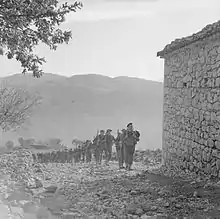
Progress for the Allied Armies in Italy (AAI), commanded by General Sir Harold Alexander, towards the end of 1943 had slowed down considerably, due mainly to a combination of worsening weather, stiffening German resistance and the Winter Line (also known as the Gustav Line, a series of formidable defences the Germans had created). The Eighth Army, operating on the Adriatic coast, had already pierced the Gustav Line at its eastern end. However, the appalling weather conditions forbade further progress and so operations there were closed down. As a result, the relatively intact 5th Division was available elsewhere. Therefore, in early January 1944 the division was transferred from the Eighth Army, now under Lieutenant-General Sir Oliver Leese, to the western side of Italy to join Lieutenant-General Richard McCreery's British X Corps. X Corps, stationed along the Garigliano river, was part of Lieutenant General Mark W. Clark's U.S. Fifth Army. The division, now commanded by Major-General Philip Gregson-Ellis and with the veteran 201st Guards Brigade now under command, crossed the Garigliano river as part of the First Battle of Monte Cassino where it gained considerable territory.[26][27]
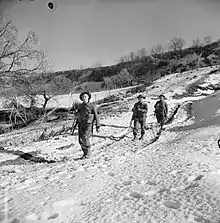
In March 1944 the division, after holding its positions that it gained during the battle, was transferred again, this time to the Anzio bridgehead (or, more appropriately, beachhead) where they came under command of Major General Lucian Truscott's U.S. VI Corps and relieved the battered 56th Division, which was returning to the Middle East. Although by this time the major battles for the Anzio beachhead were over, the division was involved in minor skirmishing and operating in conditions more reminiscent of the trench warfare of the First World War. In May the division participated in Operation Diadem and the breakout from Anzio, which led to the capture of the Italian capital of Rome in early June. During the fighting, Sergeant Maurice Rogers of the 2nd Battalion, Wiltshire Regiment was posthumously awarded the Victoria Cross, the first and only to be awarded to the 5th Division during the Second World War. Soon afterwards the division, having sustained just under 3,000 casualties since its arrival at Anzio three months before, was then withdrawn to Palestine, arriving there in mid-July. The division then came under command of Persia and Transjordan Command.[21][22]
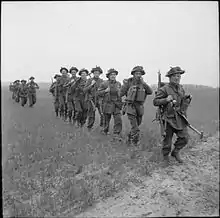
The division, now commanded by the relatively young Major-General Richard Hull, who, at the age of 37, was the youngest division commander in the British Army (and later destined to become Chief of the General Staff and Chief of the Defence Staff), returned to Italy in early 1945 where they relieved the 1st Infantry Division, which had fought alongside the Globetrotters at Anzio. Soon afterwards, however, the division was transferred to the Western Front in March 1945 to participate in the final stages of the North West Europe campaign. Arriving in Belgium just after the British crossing of the Rhine, the division came under command of VIII Corps, under Lieutenant-General Evelyn Barker, part of the British Second Army, under Lieutenant-General Miles Dempsey, and took part in the Western Allied invasion of Germany, closely supported by elements of the 6th Guards Armoured Brigade.[21][22]
Throughout the Second World War, the British 5th Infantry Division used a 'Y' on a khaki background as its insignia.[22]
Order of battle
The 5th Infantry Division was constituted as follows during the war:[22][21]
13th Infantry Brigade (detached to Force 121 in Madagascar from 26 April until 2 August 1942)[28]
- 2nd Battalion, Cameronians (Scottish Rifles)
- 2nd Battalion, Royal Inniskilling Fusiliers (30 November 1939 to 14 August 1944)
- 2nd Battalion, Wiltshire Regiment
- 13th Infantry Brigade Anti-Tank Company (from 3 September 1939, disbanded 6 January 1941)
- 5th Battalion, Essex Regiment (from 14 August 1944)
- 13th Infantry Brigade Support Company (from 4 May 1943, left 20 June 1944)
- 1st Battalion, Green Howards
- 1st Battalion, King's Own Yorkshire Light Infantry
- 1st Battalion, York and Lancaster Regiment
- 15th Infantry Brigade Anti-Tank Company (formed 29 September 1939, disbanded 6 January 1941)
- 15th Infantry Brigade Support Company (from 4 May 1943, left 14 June 1944)
17th Infantry Brigade (Brigade HQ formed 3 October 1939, detached to Force 121 in Madagascar from 15 March to 30 June 1942)[30]
- 2nd Battalion, Royal Scots Fusiliers (from 4 October 1939)
- 2nd Battalion, Seaforth Highlanders (from 4 October 1939, left 30 March 1940)
- 2nd Battalion, Northamptonshire Regiment (from 5 October 1939)
- 17th Infantry Brigade Anti-Tank Company (formed 18 October 1939, disbanded 6 January 1941)
- 6th Battalion, Seaforth Highlanders (from 30 March 1940)
- 17th Infantry Brigade Support Company (from 4 May 1943, left 6 June 1944)
Divisional Troops
- 7th Battalion, Cheshire Regiment (machine gun battalion, from 11 November 1941)
- 3rd Battalion, Tower Hamlets Rifles (Rifle Brigade (The Prince Consort's Own)) (Reconnaissance Battalion, from 15 to 29 January 1941)
- 5th Battalion, Reconnaissance Corps (formed from 3rd Tower Hamlets Rifles, 30 January 1941, redesignated 5th Regiment 6 June 1942, became 5th Reconnaissance Regiment, Royal Armoured Corps 1 January 1944)
- 9th Field Regiment, Royal Artillery (until 7 April 1942)[31]
- 91st (4th London) Field Regiment, Royal Artillery (until 26 April 1942, and again from 2 July 1942)[32][33]
- 92nd (5th London) Field Regiment, Royal Artillery (left 30 April 1940, returned 6 June 1940)[34][35]
- 97th (Kent Yeomanry) Army Field Regiment, Royal Artillery (from 14 to 31 May 1940)[36][37]
- 156th (Lanarkshire Yeomanry) Field Regiment, Royal Artillery (from 29 August 1942)[38][39]
- 52nd (6th London) Anti-Tank Regiment, Royal Artillery (from 28 December 1939)[40][41]
- 18th Light Anti-Aircraft Regiment, Royal Artillery (from 5 February 1943)[42]
- 245th (Welsh) Field Company, Royal Engineers (from 29 December 1939)
- 252nd (West Lancashire) Field Company, Royal Engineers (from 29 December 1939)
- 506th Field Company, Royal Engineers (until 29 January 1940)
- 38th Field Company, Royal Engineers (from 29 January 1940 until 7 April 1942, and again from 30 June 1942)
- 254th (West Lancashire) Field Park Company, Royal Engineers (from 29 December 1939)
- 18th Bridging Platoon, Royal Engineers (from 16 March 1943)
- 5th Divisional Signals Regiment, Royal Corps of Signals
Post War and Cold War
The division remained in Germany, undertaking occupation duties, into the immediate post-war period. Major-General John Churcher was the final commander, taking command in July 1947 and the division was disbanded two months later in September.[43][44][lower-alpha 1] In April 1958, as part of a restructure undertaken by the British Army of the Rhine (BAOR), the 7th Armoured Division was converted into and became the newly revived 5th Division and was headquartered at Verden an der Aller, Germany. This incarnation of the division lasted until 30 June 1960. The following day, 1 July, it was redesignated as the 1st Division and took on that formation's lineage and insignia.[22][43][45]
On 1 April 1968, the Army Strategic Command was formed in the UK, with a goal of supporting NATO forces from as far north as Norway to as far south as Turkey; to provide internal security operations world-wide; and to undertake limited operations alongside allied forces. In conjunction with this command being formed, the 5th Division was resurrected at Wrexham. During this period, it consisted of the 2nd, the 8th, and the 39th Infantry Brigades. However, with the onset of Operation Banner, the deployment of British troops to Northern Ireland during The Troubles, the division was disbanded on 26 February 1971 as it was no longer needed.[43][46][47]
Final decades
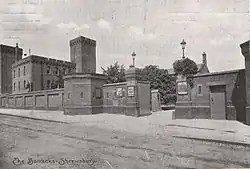
During the mid-1990s, the British Army restructured and disbanded various regional districts, which were replaced by several regionally based divisions. This included the reformed 5th Division, alongside the 2nd and the 4th Divisions. These formations were all dubbed "regenerative" divisions, and held administrative and training responsibilities for all non-deployed forces located within their geographical boundaries. For the 5th Division, this included Wales, the West Midlands, and North West England. In the event of a major international crisis, the formation would be used as the core to form a combat-ready division around. On reformation (April 1995), the division was headquartered in Shrewsbury and comprised the 42nd Brigade (headquartered in Preston, Lancashire), the 143rd Brigade (Shrewsbury), and the 160th Infantry Brigades (Brecon). At the time, it was around 4,600 strong and also contained 97 artillery pieces, one multiple launch rocket system, two helicopters, and 123 tracked vehicles.[43][49][50]
As part of its training mandate, the division dispatched troops to train in Belize, was the first British formation to undertake training operations in Slovakia, and regularly worked with the Army Cadet Force.[51] In addition to training, the division was held responsible for environmental conservation in areas that it oversaw. It also conducted a number of UK-based humanitarian missions in the early 2000s. During Operation Waterfowl, the division assisted those effected by the Autumn 2000 Western Europe floods. In 2001, the division supported farmers across the country, as well as the Ministry of Agriculture, Fisheries and Food, during the 2001 United Kingdom foot-and-mouth outbreak (its deployment falling under the codename Operation Peninsular).[52] The same year, it also sent troops to join the Stabilisation Force in Bosnia and Herzegovina (Operation Palatine).[53]
By the mid-2000s, the division's boundaries had changed. The 2nd Division was assigned northern England and the 42nd Brigade. In turn, the 5th Division's area of responsibility was expanded so that it stretched from Wales, across the Midlands, and included the East of England. It also took command of the 49th (East) Brigade.[54][55][lower-alpha 2] The opening decade of the millennium saw the outbreak of the War on terror, which resulted in British deployments to Afghanistan (Operation Herrick) and Iraq (Operation Telic and the division prepared troops for deployments to these conflicts. It also sent troops to the Falkland Islands.[55]
The Strategic Defence and Security Review of 2010 identified that the army had had become optimised for operations in Afghanistan, but in order to meet potential future threats would need to be reorgnised to become more flexible. This restructure was called Army 2020 and resulted in the decision to disband the three regional regenerative divisions, to be replaced by Support Command, with the aim of making the home-based forces better able to support any deployed troops. The 5th Division was disbanded alongside the 2nd during April 2012, with the 4th Division preceding them in January.[57]
See also
Notes
Footnotes
- The Imperial War Museum stated that the division was disbanded in 1946.[22]
- Charles Heyman, a defence analyst, provides a different geographical area for the division during this period: Wales, the East Midlands, and South West England.[56]
Citations
- Pivka, p. 16
- Lipscombe, Nick (2014). Bayonne and Toulouse 1813–14: Wellington invades France. Osprey. p. 23. ISBN 978-1472802774.
- "The Battle of Waterloo". Retrieved 2 February 2013.
- Col John K. Dunlop, The Development of the British Army 1899–1914, London: Methuen, 1938, p. 74.
- L.S. Amery (ed), The Times History of the War in South Africa 1899-1902, London: Sampson Low, Marston, Vol II, pp. 283–4.
- Times History, Vol III, pp. 206–15.
- "Ladysmith history and the Boer War". Archived from the original on 28 June 2010. Retrieved 2 February 2013.
- Times History, Vol IV, Appendix to Chapters I-XIV, pp. 503–14.
- "The Battle of Val Krantz and Pieters". Archived from the original on 15 January 2013. Retrieved 2 February 2013.
- Coke's 10th Brigade
- 10th Battalion
- Woodgate's 11th Brigade
- Kings Own
- Manning, Stephen (2020). Bayonet to Barrage: Weaponry on the Victorian Battlefield. Pen and Sword. p. 196. ISBN 978-1526777218.
- Monthly Army List, January 1899.
- "The 5th Division in 1914–1918". Retrieved 13 August 2020.
- Williamson, Howard J.; Bate, Chris (2020). The award of the Military Medal for the campaign in Italy 1917-1918. privately published by Anne Williamson. ISBN 978-1-8739960-5-8.
The book includes: – A detailed overview of the Italian Campaign and its battles. – Notes on the [five] Divisions engaged in Italy.
- Becke, pp. 65–71.
- Osprey Publishing MAA 182, p.9
- "Reinforcements For Palestine: Organization Of The 5th Division". The Times. No. 47480. 15 September 1936. p. 7.
- Joslen 2003, pp. 47–48.
- "Badge, formation, 5th Infantry Division". Imperial War Museum. Retrieved 1 July 2023.
- Joslen 2003, p. 272.
- War Diaries 1939-45, Field Marshal Lord Alanbrooke, p. 73
- "Journey of the Globetrotters' by Dennis March". BBC. Retrieved 1 September 2016.
- Joslen 2003, pp. 47–48, 266.
- "5th Division". Battlefields. Retrieved 15 August 2015.
- Joslen 2003, pp. 251–252.
- Joslen 2003, pp. 253–254.
- Joslen 2003, pp. 259–260.
- "9 Fd Rgt at RA 1939–45". Archived from the original on 24 September 2015. Retrieved 8 February 2015.
- Litchfield, pp. 152–3.
- "Rgt at RA 1939–45". Archived from the original on 22 August 2004. Retrieved 8 February 2015.
- Litchfield, pp. 153–5.
- "Rgt at RA 1939–45". Archived from the original on 24 September 2015. Retrieved 8 February 2015.
- Litchfield, pp. 111–2.
- Rgt at RA 1939–45. Archived 14 September 2013 at the Wayback Machine
- Litchfield, p. 294.
- Rgt at RA 1939–45. Archived 30 January 2013 at the Wayback Machine
- Litchfield, p. 156.
- at RA 1939–45.
- "18 LAA Rgt at RA 1939–45". Archived from the original on 24 September 2015. Retrieved 8 February 2015.
- Lord & Watson 2003, pp. 34–35.
- "Obituaries: Major-General John Churcher". The Times. No. 65973. 20 August 1997.
- "Army Notes". Royal United Services Institution. 105:619 (619): 430–434. 1960. doi:10.1080/03071846009421132.
- Kneen & Sutton 1996, pp. 253–254, 256.
- "No. 45322". The London Gazette (Supplement). 16 March 1971. p. 2269.
- The Army List. London: Stationery Office. 2000. p. 54. OCLC 655399772.
- Tanner 2014, p. 13.
- Heyman 1997, pp. 14, 22–23, 28–29.
- "5th Division, Royal Welch Fusiliers in Central America". Ministry of Defence. Archived from the original on 20 February 2003. Retrieved 1 July 2023., "5th Division, Slovakia 'First' For Welsh Volunteer Soldiers". Ministry of Defence. Archived from the original on 20 February 2003. Retrieved 1 July 2023., and "5th Division, South West Army Cadet Force Annual Camps". Ministry of Defence. Archived from the original on 20 February 2003. Retrieved 1 July 2023.
- "5th Division, Environment and Land Use". Ministry of Defence. Archived from the original on 27 February 2003. Retrieved 1 July 2023., "5th Division, Operation Peninsular". Ministry of Defence. Archived from the original on 7 April 2003. Retrieved 1 July 2023., and "5th Division, Operation Waterfowl". Ministry of Defence. Archived from the original on 20 February 2003. Retrieved 1 July 2023.
- "5th Division, Operation Palatine". Ministry of Defence. Archived from the original on 20 February 2003. Retrieved 1 July 2023.
- Tanner 2014, p. 13; Heyman 2007, pp. 40–41.
- "5th Division". Ministry of Defence. Archived from the original on 13 December 2008. Retrieved 1 July 2023.
- Heyman 2007, pp. 40–41.
- Tanner 2014, pp. 7, 14.
References
- Becke, Major A.F. (1935). History of the Great War Based on Official Documents. Order of Battle of Divisions: Part 1 - The Regular British Divisions. London: HMSO.
- Heyman, Charles (1997). The British Army Pocket Guide 1997/1998. Barnsley: Pen & Sword Books. ISBN 978-0-85052-539-7.
- Heyman, Charles (2007). The British Army: A Pocket Guide 2008–2009. Barnsley: Pen & Sword. ISBN 978-1-78340-811-5.
- Joslen, H. F. (2003) [1960]. Orders of Battle: Second World War, 1939–1945. Uckfield, East Sussex: Naval and Military Press. ISBN 978-1-84342-474-1.
- Kneen, J. M.; Sutton, D. J. (1996). Craftsmen of the Army: The Story of the Royal Electrical and Mechanical Engineers 1969–1992. Vol. II. London: Leo Cooper. ISBN 978-0-850-52549-6.
- Lord, Cliff; Watson, Graham (2003). The Royal Corps of Signals: Unit Histories of the Corps (1920–2001) and its Antecedents. West Midlands: Helion. ISBN 978-1-874622-07-9.
- Norman E.H. Litchfield, The Territorial Artillery 1908–1988 (Their Lineage, Uniforms and Badges), Nottingham: Sherwood Press, 1992, ISBN 0-9508205-2-0.
- Tanner, James (2014). The British Army since 2000. Oxford: Osprey Publishing. ISBN 978-1-78200-593-3.
- Von Pivka, Otto (1973). The Black Brunswickers. Osprey Publishing. ISBN 978-0850451467.
Further reading
- Aris, George; Durtnell, C. S. (1959). The Fifth British Division 1939 to 1945. London: Fifth Division Benevolent Fund. OCLC 5061728.
- Gleichen, Edward (2007) [1917]. Infantry Brigade: 1914 – The Diary of a Commander of the 15th Infantry Brigade, 5th Division, British Army, during the Retreat from Mons. Driffield, Yorkshire: Leoanur. ISBN 978-1-84677-364-8.
- Hussey, Arthur Herbert (1919). Narrative of the 5th Divisional Artillery. Woolwick: Royal Artillery Institution. OCLC 12016278.
- Hussey, Arthur Herbert; Inman, D. S. (1921). The Fifth Division in the Great War. London: Nisbet & Co. OCLC 6162945.